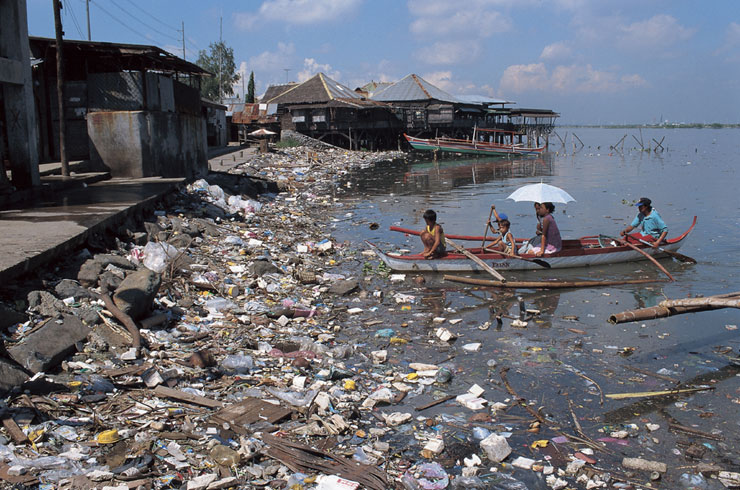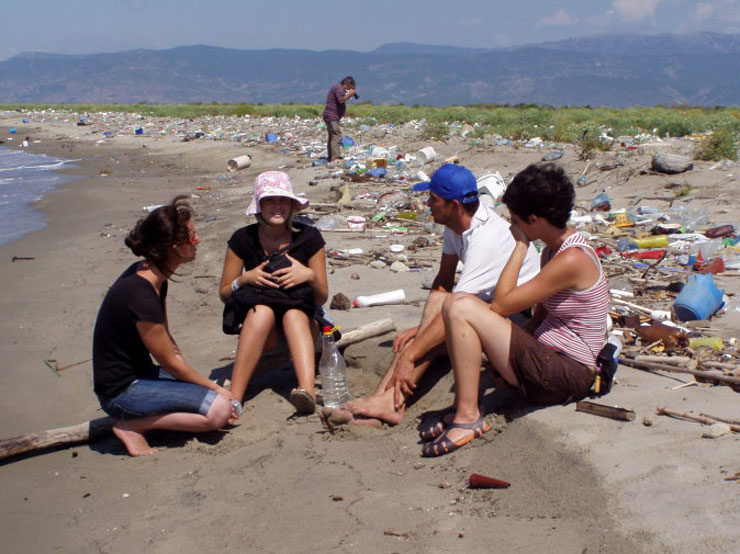Land-Based Pollution Has Massive Adverse Effects On Coastal Communities
By Marianne de Nazareth
25 February, 2013
Countercurrents.org

As humans we are the dominant species on this tottering planet of ours and pollution has become an issue which has to be dealt with on a war footing today. This is because we have been careless about disposing of our waste and effluents and so now the impact is being felt across the planet on a variety of communities. Looking at how land based pollution is causing impacts on coastal communities, the pollution can come from various sources including general, sediments, nutrients, wastewater and litter pollutants.
Those of us who live inland could ask, why should we care? We don’t live near the ocean. Well, considering that oceans and major seas cover 70.8 % or 362 million km2 of the Earth’s surface and that half of the oxygen produced comes from oceans, we need to care, as it does affect us. Also, 90% of the world’s goods are transported by sea and 95% of the world's annual marine fish catch is from coastal/shelf fisheries.
All the stunning coastal and marine ecosystems (meaning coral reefs, mangroves, seagrasses, estuaries, lagoons and beaches) are important to the well being of our planet. Plus 21 of the world’s 33 mega cities are on the coast where these fragile ecosystems are at risk. 60% of the world’s population lives within 200km of the seashore. These coastal ecosystems sustain and regulate our living environment, provide food and livelihoods, and a source of recreation, culture and spiritual wellbeing.
Coral reefs, mangrove forests, seagrass meadows and saltmarshes are particularly valuable for the ecosystem services they provide.Healthy coastal ecosystems decrease vulnerability to climate change effects and extreme events, and reduce costs of infrastructure maintenance. For example, they buffer storm surges during times of hurricanes, which is sometimes referred to as providing “ecosystem services”. New York city took a decision after Super Storm Sandy to invest in such a buffer to protect the city from future events, by restoring degraded natural waterfront areas, protecting wetlands and building seawalls. But why do we need to be brought to our knees to understand that we cannot pollute in whatever way we like?
Economically too the ocean is import as, 275 million people depend directly on reefs for livelihoods and sustenance. Healthy reefs can produce up to 35 tons of fish per square kilometer each year and in Mexico, mangroves support small-scale commercial fisheries worth USD 3.75 million per square kilometer. Tourism is one of the fastest growing sectors worldwide, making up 5% of global GDP, 6% of jobs and 10% of investments. Income from reef and beach tourism in the Caribbean makes up two thirds of the region’s GDP.
If we take a look at the current state of ocean and coastal and marine ecosystems, up to half of the world’s mangrove forest and tidal marsh area has been lost and the global area of seagrass has declined by a third in the past century. A fifth of the world’s coral reefs have been lost, and more than 60 % is under immediate, direct threat. In my state of Goa, the beaches are dirty with litter and human careless disposal of all their waste.
Scientists like Vincent Sweeny who heads the UNEP’s global programme of action for the protection of the marine environment from land based activities says, “ The causes are an estimated 80 % of all pollution in seas and oceans comes from land-based activities.”
Nearly 75% of added nutrients in agriculture, end up lost to the environment, wasting the energy used to produce them, and causing pollution through emissions of the greenhouse gas nitrous oxide (N2O) and ammonia (NH3) to the atmosphere, plus losses of nitrates (NO3), phosphate and organic N and P compounds to water, much of which reaches the coast. Between 1960 and 1990 the global use of synthetic nitrogen fertilizer increased more than sevenfold, while phosphorus use more than tripled. FAO predicts that by 2030 global nitrous oxide (N2O) emission from fertilizer and manure application will increase by 35% to 60%. The Global Warming Potential of N2O is 296 times greater than a unit of CO2. Some 20 million tonnes of phosphorous are mined every year and nearly half of this - 8 times the natural rate of input - enters the world’s oceans.
In countries like Africa and India, untreated wastewater which could be up to 90 per cent, flows untreated into the densely populated coastal zone contributing to growing marine dead zones, which already cover an area of 245 000 km, approximately the same area as all the world’s coral reefs. This corresponds to an estimated global loss of ecosystem services which equals USD 200 billions/year.
Contaminated water from inadequate wastewater management provides one the greatest health challenges restricting development and increasing poverty through costs to health care and lost labour productivity. Worldwide, some 2.6 billion, almost half the population of the developing world do not have access to adequate sanitation. At least 1.8 million children under five years old die every year due to water related disease, accounting for around 17 per cent of deaths in this age group. Worldwide some 2.2 million people die each year from diarrhoeal disease. Poor hygiene and unsafe water is responsible for around 88 per cent of all diarrhoeal incidents.

Litter which could be plastics like bottles or packets or even bubble wrap, is found in all the world's oceans and seas. This is because of the increase in world population of 26%, in tourism of 90% and in plastics use of 130% over the last 20 years, the amount of waste ending up in our oceans is increasing. The UK has spent a mind boggling $3.9M to clean 900 km of coastline. In Sweden, a small fishing community looses over $1M per year. In the USA, insurance companies have to pay over $50M in claims from fishermen. Again in the UK, there have been 200 rescues at sea because of fouled propellers, leading to>$1.6M per year. It was in Muntinlupa City, which is in the Philippines where they banned not only plastic bags but also polysterene, commonly known as Styrofoam (a brand name) when a tropical storm struck in 2011. With its waterways free from plastic bags and Styrofoam debris, the city was flood-free despite the heavy rains brought by Tropical Storm “Falcon.”
It is possible to help ourselves by using wastewater as a resource for its nutrients; water augmentation; reaping methane from it. Wastewater use is widespread and 50 countries worldwide irrigate between 5 -20 million hectares using wastewater. These statistics could be higher because most of the use is unreported and not regulated says the FAO. Waste water contains macro nutrients, micro nutrients and organic matter and thus reduces the demand for chemical fertilisers – and for the urban poor it may be the only source of fertilisers they can access. In addition, the resource is available all year round and thus allows for more types of crops, more crops per year and consequently higher incomes.In most of African countries wastewater is re-used but in untreated condition. However humans do not consider waste water as a resource. Farmers should be educated about nutrient-use efficiency, leading to reduction in use , which could save billions potentially. In China apparently they have begun an injection of “capsules” of nutrients to cut back on fertilizer use.
There should be a ban of single-use plastic bags. Between 500 billion and a trillion plastic bags are consumed worldwide each year, according to the United States Environmental Protection Agency.Plastic bags take between 20 and 1,000 years to break down in the environment. Less than 1 percent of the bags are recycled because it costs more to recycle a bag than to produce a new one. It costs $4,000 to process and recycle a ton of plastic bags, which can then be sold for $32.If the economics don’t work, recycling efforts don’t work. In Kenya, UNEP is helping the city of Nairobi develop the infrastructure needed for the collection and recycling of plastic bags and the parallel introduction of a tax.
A fantastic example is Muntinlupa City, in the Philippines, which reaped the benefit of banning not only plastic bags but also polysterene, commonly known as “Styrofoam.” When a tropical storm struck in 2011,with its waterways free from plastic bags and Styrofoam debris, the city was flood-free despite the heavy rains brought by Tropical Storm “Falcon.”
Today the world has to look at recycling of plastics making them into new products or as fuel. It is an easily accessible and cheap product material, which can be sustained till plastic runs out and humans realise how harmful they are to our environment. Land based pollutants are causing havoc to our coastal areas and we have to decide to do something concrete soon or our entire planet is in peril.
(The writer is a freelance science and environment journalist, adjunct faculty St. Joseph’s College and a registered PhD scholar in MKU)
Comments are moderated


